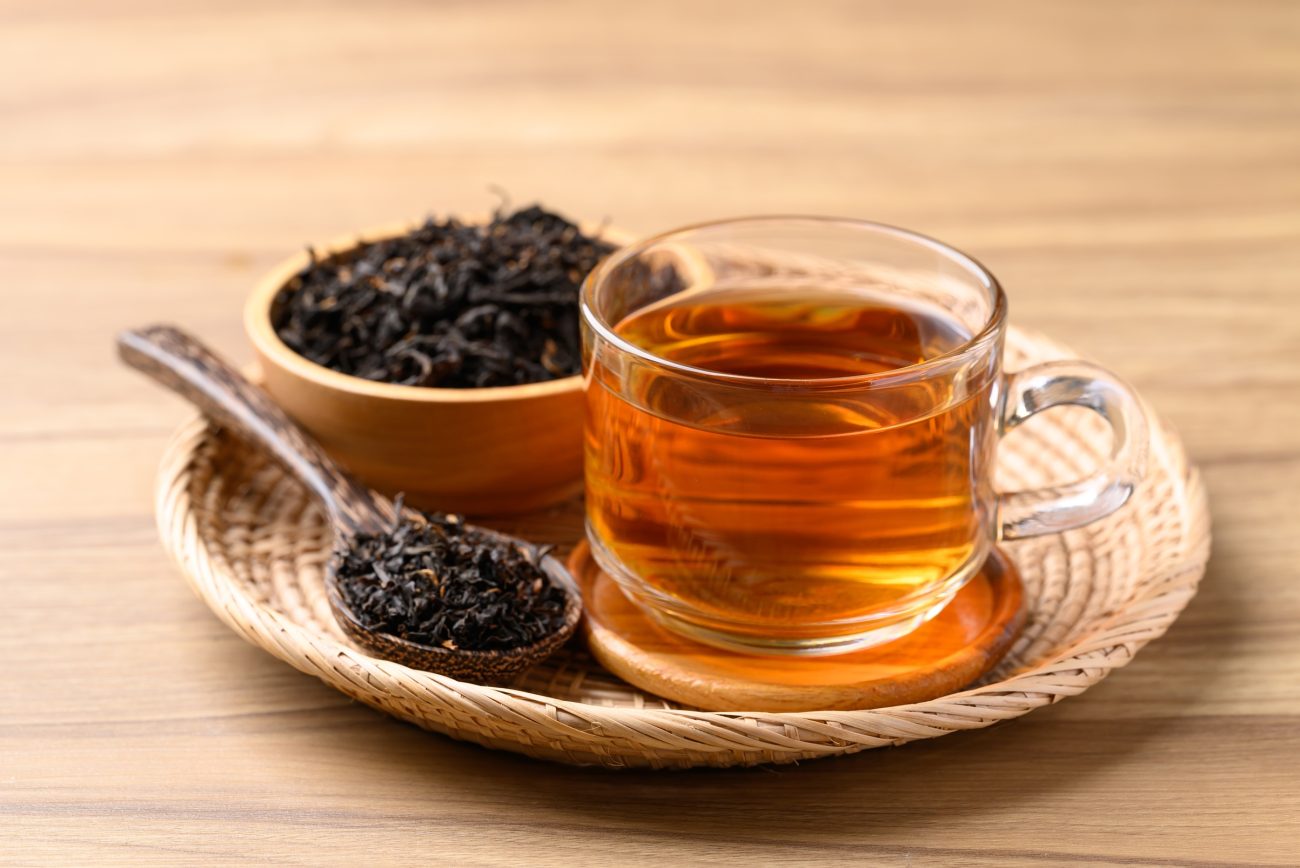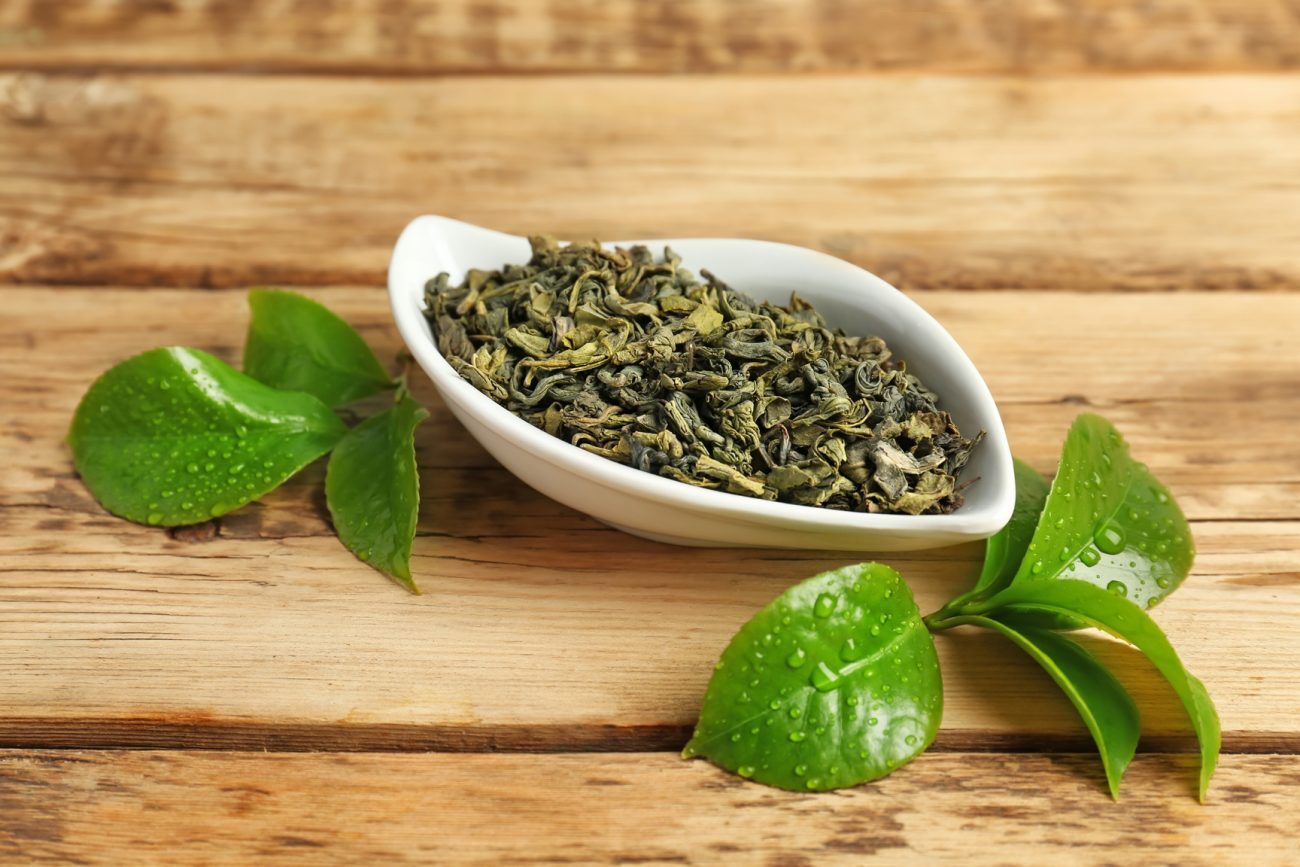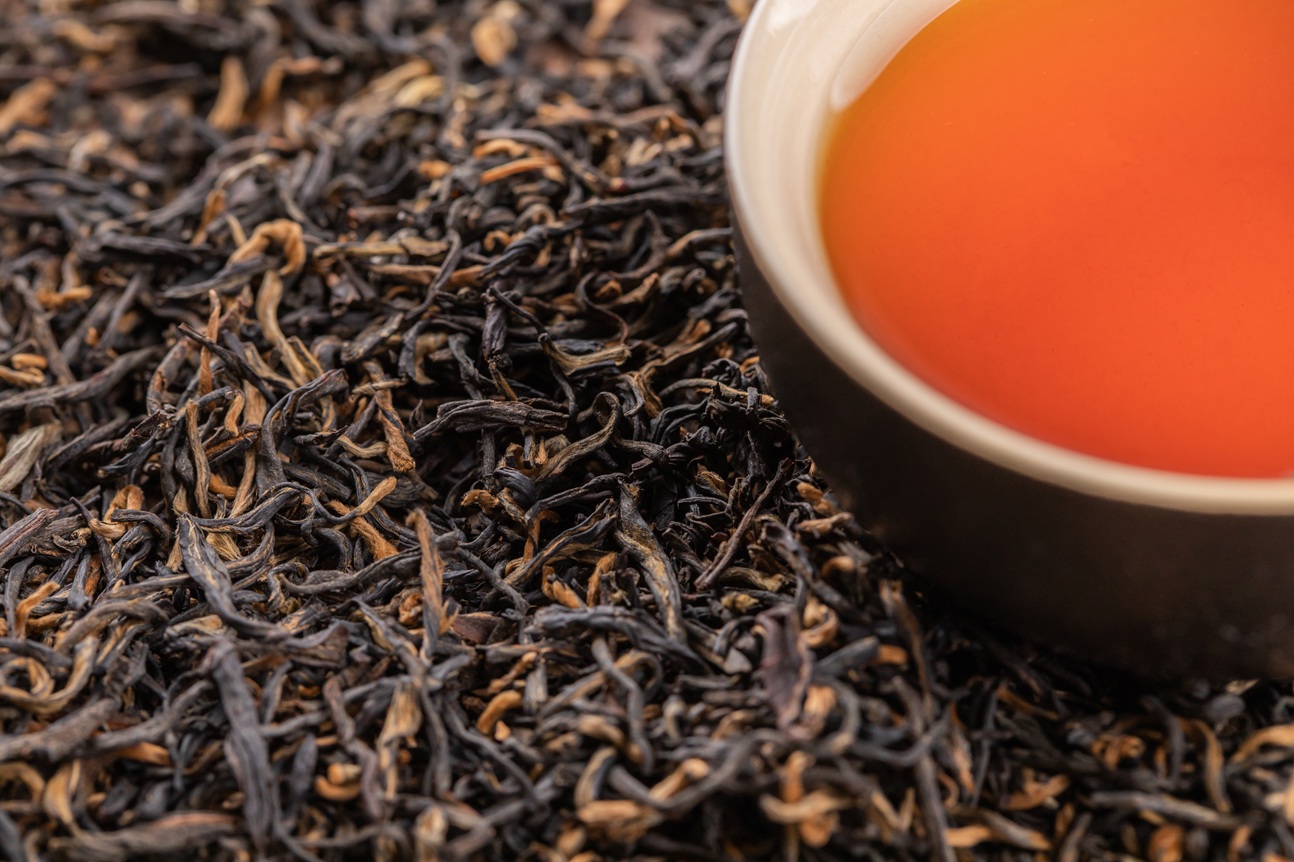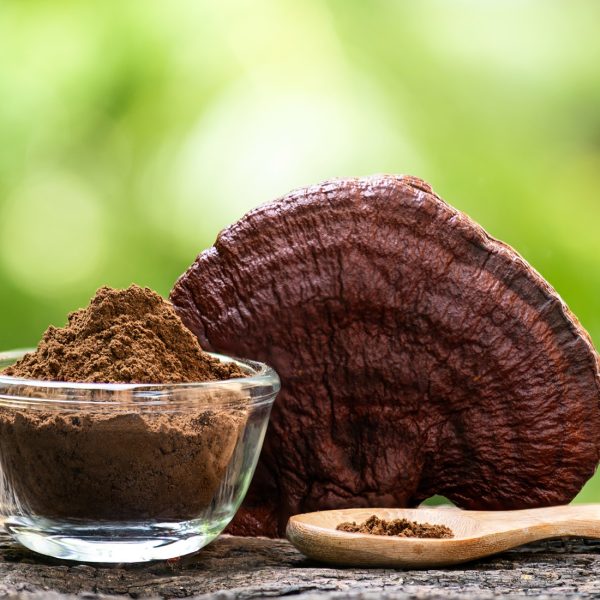Liupao tea was found to affect blood pressure, blood lipids, body weight and composition in adults with metabolic syndrome, with significance increasing with fermentation duration.
In this article, we summarise the paper “A randomized double-blind trial of the effect of Liupao tea on metabolic parameters, body composition, and gut microbiota in adults with metabolic syndrome” (1).
Plant name and species
Camellia sinensis prepared as liupao tea — a fermented dark tea rich in polyphenols
Aim of study
To evaluate the effects of Liupao tea of different ages on patients with metabolic syndrome in relation to biochemical markers, body weight, body composition and gut microbiota.
Study method

The study was randomised, double-blind and a longitudinal experimental design. Participants were aged between 18 and 70 years and diagnosed with metabolic syndrome according to Chinese Guidelines for the Prevention and Treatment of Type 2 Diabetes (2022 edition) (2). Exclusion criteria precluded the participation of anyone with chronic illnesses — such kidney, liver, blood or heart disease — or were taking any medications that affected their blood glucose, blood lipids or blood pressure, any pregnant or lactating women, any individuals with allergies to tea ingredients, anyone with restrictive dietary habits (such as the ketogenic diet) and anyone with severe mental illness or trauma.
Participants randomised to one of four groups:
- 1-year old fermented tea n=19
- 4-year old fermented n=19
- 7-year old fermented n=19
- 10-year old fermented n=19.
The following measures were taken:
- Visual Analogue Scale (VAS) to evaluate patient appetite — hunger, fullness, mood etc out of a total of 500 points
- Fasting venous blood following an overnight fast for fasting blood glucose, HbA1c, blood lipids, insulin, hepatic and muscle biomarkers
- Body composition via a bioelectrical impedance analyser — body weight, body fat mass, skeletal muscle mass, body fat percentage, lean body mass, visceral fat area
- Waist circumference
- Blood pressure
- Faecal DNA analysis and library construction for diversity analysis and taxonomic classification of gut microbiota
Herbal preparation
Participants consumed 6 g (one teabag) of Liupao tea per day for 90 days. Tea was brewed with 250 ml of boiling water in a teapot and steeped for up to 45 seconds before drinking. The tea was consumed 1–2 hours after breakfast or lunch and was finished before 3 pm.
Sample size
A power calculation was used to determine group sizes and there were n=19 participants in each group. Participants were encouraged to engage with the study via an App. Five were lost to follow-up.
Results of study
Fifty-two females and 19 males completed the study. With the five lost to follow up the final groups were: 1-year old tea (n=19), 4-year old tea (n=17), 7-year old tea (n=18) and 10-year old tea (n=17). There were no differences in any of the demographic measures between the groups. There was an equal split of whether people were regular tea drinkers or not.

Blood pressure
Systolic blood pressure significantly reduced in the 4-, 7- and 10-year tea groups, whilst diastolic pressure only reduced in the group drinking the 10-year tea (p<0.05).
Blood lipids and biomarkers
Total cholesterol reduced in the one-year aged tea group. HDL-C was elevated in the 4- and 7- year aged groups, and LDL-C was reduced across all of the groups compared to baseline (p<0.05).
Apolipoprotein A1 was significantly reduced in the teas that were 1-, 7- and 10-year aged, but apolipoprotein B did not change.
The teas had no significant effects on other parameters such as fasting blood glucose and liver health biomarkers.
Body composition
The teas significantly reduced average body weight with groups losing on average 1–2 kg over the 90 day trial. This corresponded with significant reductions in body fat mass, body fat percentage and visceral fat area. Body mass index and waist circumference decreased in the 4-, 7- and 10-year-aged groups (p < 0.05).
Participant appetite scores did not alter.
Faecal microbiota
Diversity
The seven-year-aged group exhibited an increase in the number of unique Amplicon Sequence Variants (ASVs) after intervention, whereas other groups showed a decrease. This suggests there were shifts in populations. The α-diversity of gut microbiota in the four groups revealed no significant differences before and after intervention across the age range of teas. So for the seven-year aged tea, there were different species apparent, but overall diversity did not change as presumably some species swapped in and out.
Phylum and genus level changes
For individual phyla, Firmicutes and Bacteroidota were dominant in the participants as a whole group. Following the tea intervention, the relative abundances of Firmicutes decreased in the 1-, 4- and 10-year-aged groups, while Bacteroidota abundance decreased in the one-, four- and seven-year-aged groups.
At the genus level, the overall gut microbiota were comparable in structure across the four tea groups. The most abundant genus in all groups was Bacteroides followed by Prevotella 9 and Faecalibacterium. The changes observed included reductions in Stenotrophomonas and Rothia, and an elevation in Eubacterium hallii in the one-year aged tea group. Elevation of Allobaculum, Monoglobus, and Eubacterium ventriosum in the four-year aged tea group. Reduction in Holdemania in the seven-year aged tea group.
Microbial and metabolic correlations
Using Spearman’s correlation, there were associations between microbial changes and metabolic indicators in the different tea groups. Firstly, Akkermansia displayed a strong inverse relationship with body mass index in the one-year- and seven-year-aged groups. Subdoligranulum was significantly negatively correlated with both triglyceride and insulin levels in the one-year aged group. Other associated changes are also presented.
Discussion

Liupao tea is a variety of dark tea of ancient origin prepared from the Camellia sinensis plant that grows specifically in Liu Pao in the Guangxi Province in China. The tea is fermented over several years which converts catechins into tea polysaccharides and notably the polyphenol theabrownin. Similar to Pu-erh tea, this tea is enjoyed because of its unique aroma and flavour. Theabrownin and other tea polyphenols have been extensively researched for their lipid-lowering, anti-inflammatory and pre-biotic properties. The present study explored whether differing durations of fermentation would affect metabolic and microbial parameters in participants with diagnosed metabolic syndrome.
The teas that were consumed for 90 days had blood pressure-lowering and lipid-modifying effects. The tea did not affect fasting blood glucose or insulin. The teas significantly reduced average body weight over the 90-day trial, with reductions in body fat including the visceral fat area. Overall, these changes were seen more for teas that were fermented and aged for 4, 7 and 10 years.
Other meta-analyses have shown that tea consumption (green and black analysed together) can reduce body weight, body mass index and modify lipid profiles favourably in patients with metabolic disease (3). For the Liupao tea, the suggested mechanisms related to the cholesterol-lowering properties of theabrownin which increases faecal excretion of bile acids and reduces lipogenesis.
Other mechanisms are purported to involve the gut microbiota. Using a faecal microbiota transplantation method in an animal model, Liupao tea extract improved the abundance and species diversity of microbiota including commensals Lactobacillus and Dubosiella; These changes were associated with weight loss and improved glucose and lipid metabolism (4). In the present study, there were no significant differences in microbial diversity but there were genus and species changes across the groups. Both Firmicutes and Bacteroidota genera declined in the 4, 7 and 10-year aged tea groups. Reducing the ratio between these genera reported to improve intestinal barrier function. Other changes included reductions in Stenotrophomonas which is an opportunistic pathogen.
In supplementary information, the total polyphenol composition of the teas was compared. Levels of theabrownin increased from year one, to four and seven, whilst the 10-year aged tea was similar to seven. The levels of soluble dietary fibre were highest in the 7- and 10-year aged teas, which could have also accounted for the microbial changes. Other compounds such as total flavonoids and caffeine were similar across the teas.
Conclusion
Liupao tea, particularly if well-aged, improved blood pressure and blood lipids in patients with metabolic syndrome. Positive changes in body weight and composition were observed, and there were changes in gut microbiota genera and species abundance rather than observable changes in diversity.
Liupao tea could provide a natural and simple approach to managing metabolic health. Future studies could explore longer timeframes for ingestion, determine which age of tea is the most optimal, and also to compare it to other forms of tea such as green and black. Further work could explore the relationships between gut microbiota composition and specific health outcomes.
References
- Wang Y, Hu Q, Jiang Q, Jiang J, Li B, Ma D. A Randomized Double-Blind Trial of the Effect of Liupao Tea on Metabolic Parameters, Body Composition, and Gut Microbiota in Adults with Metabolic Syndrome. Nutrients. 2025; 17(14):2371. https://doi.org/10.3390/nu17142371
- Chinese Elderly Type 2 Diabetes Prevention and Treatment of Clinical Guidelines Writing Group; Geriatric Endocrinology and Metabolism Branch of Chinese Geriatric Society; Geriatric Endocrinology and Metabolism Branch of Chinese Geriatric Health Care Society; Geriatric Professional Committee of Beijing Medical Award Foundation; National Clinical Medical Research Center for Geriatric Diseases (PLA General Hospital). Clinical guidelines for prevention and treatment of type 2 diabetes mellitus in the elderly in China (2022 edition). Zhonghua Nei Ke Za Zhi 2022, 61, 12–50. https://doi.org/10.3760/cma.j.cn112138-20211027-00751
- Xiao, T., Li, Y., Li, H., Wang, K., Huang, J., Liu, Z., & Zhu, M. (2024). Tea consumption in relation with metabolic syndrome and obesity: A systematic review and meta-analysis of randomized clinical trials. Food Bioscience, 61, 104322. https://doi.org/10.1016/j.fbio.2024.104322
- Zhou H, Wang X, She Z, Huang L, Wei H, Yang S, Wei Z, Chen H, Yang B, Hu Z, Feng X, Zhu P, Li Z, Shen J, Liu H, Dong H, Chen G, Zhang Q. Combining bioinformatics and multiomics strategies to investigate the key microbiota and active components of Liupao tea ameliorating hyperlipidemia. J Ethnopharmacol. 2024 Oct 28;333:118438. https://doi.org/10.1016/j.jep.2024.118438


























